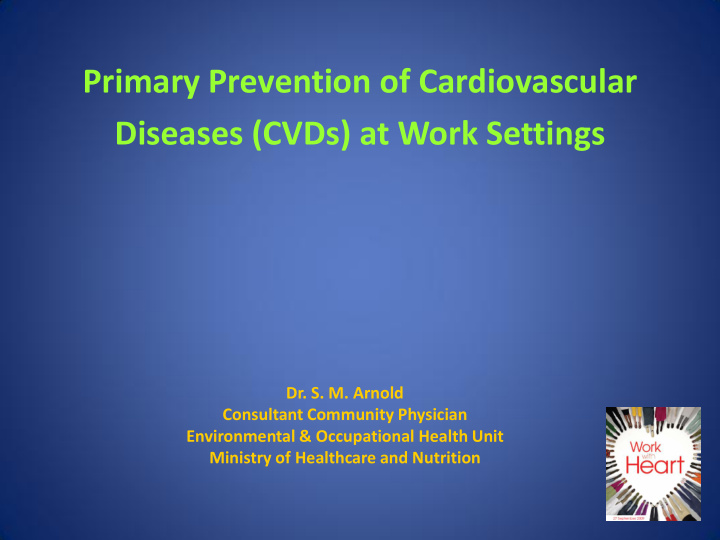



Primary Prevention of Cardiovascular Diseases (CVDs) at Work Settings Dr. S. M. Arnold Consultant Community Physician Environmental & Occupational Health Unit Ministry of Healthcare and Nutrition 1
Chronic Non Communicable Disease are now the leading causes of mortality, morbidity, and disability in Sri Lanka • Cardiovascular Diseases (CVD) - Heart disease, Stroke, Hypertension • Diabetes • Chronic Respiratory Disease • Chronic Kidney Disease • Cancer 2
Nearly 80% of premature deaths from CVD could be avoided if the main risk factors are controlled Tobacco Unhealthy diet Physical inactivity 3
Work & Diseases Most of us spend > ½ our waking hours working A workplace that encourages healthy habits can reduce your risk of many diseases, including CVDs 4
Health & Business Many businesses have recognized the importance of employee health to achieve core business objectives and have committed to include health promotion on their corporate agenda. However, it is still mostly large corporations that offer workplace health programmes. In smaller businesses or where people are self- employed, it is the individual who has to take action. 5
4 Good Reasons To Work With Heart 1. Save lives Almost half of those who die from chronic diseases, including heart disease and stroke, are in the productive period of their lives – between 15 and 69 years old. Yet many of the causes of these diseases – tobacco, unhealthy diet, or not being physically active – are factors we can control 6
2. Increase personal well-being • Employees engaged in physical activity have greater enjoyment of their work, increased concentration and mental alertness, and better rapport with colleagues. • Activity stimulates endorphins, nature’s natural mood boosters, giving you plenty of enthusiasm for your leisure when you’ve finished work, relaxes the mind and body, and helps to reduce the build-up of tension. 7
3. Enjoy social benefits Activities in groups, with colleagues, clubs or leisure centres, are great for meeting people outside your usual team and expanding your network of friends. Feeling healthy and developing new skills builds confidence and can help you feel more in control of your life 8
4. Economic payback • A healthy workforce can contribute to the health of a business in many ways – even in times of economic slow- down Benefits include: – increased productivity – reduced absenteeism rates-up to 20% fewer days lost – lower medical costs (for both employers & employees) – fewer workplace injuries – a positive corporate image – improved morale and loyalty – enhanced staff retention. 9
Healthy Work Place Promoting • Physical activity • Healthy eating Discouraging • Smoking and other forms of tobacco use in and around the workplace can be simple and inexpensive 10
How you can take steps towards a healthier workplace • Be physically active during your day • Participate in an existing sport or fitness group and tell your colleagues about it •Get active and take heart 1. Even 30 minutes of activity can help to prevent heart attacks and strokes and your work will benefit too. 2. Take the stairs 3. Go for a walk during your break 4. Get off the bus a couple of stops earlier and walk the rest of the way 11
• Provide your colleagues with information about the benefits that they can gain from being physically active on a regular basis • Help others who want to be active to make their first moves. 12
How you can take steps towards a healthier workplace… • Ask for healthy food at your work canteen, or find nearby cafes that serve healthy meals. • Healthy food intake – Eat at least five servings of fruit and vegetables a day. • Make smart choices, like choosing the “healthy menu” in your canteen or bringing your own food from home • Use less salt and avoid processed foods – Try to limit your salt intake to about a teaspoon per day. Be wary of processed foods, which often contain high levels of salt. 13
How you can take steps towards a healthier workplace… • Insist on a smoke-free environment • Say no to tobacco – Your risk of coronary heart disease will be halved within a year and will return to a normal level over time • Talk with your human resources or line manager about how to establish a healthy workplace policy 14
How you can take steps towards a healthier workplace… • Maintain a healthy weight Weight loss, especially together with lowered salt intake, leads to lower blood pressure. High blood pressure is the number one risk factor for stroke and a major factor for approximately half of all heart disease and stroke 15
• Know your numbers Visit a health-care professional who can measure your blood pressure, cholesterol and glucose levels, together with waist-to-hip ratio and Body Mass Index. Once you know your overall risk, you can develop a specific plan of action to improve your heart health 16
Establishing Healthy Workplaces • Establishment of health policies e.g. no tobacco use in the buildings • Encouraging good eating habits e.g. healthy canteens • Encouraging workers to exercise during their breaks • Offering information and services to workers • Health checkups for risk factors for CVD 17
Healthy Workplace Main Stakeholders: Ministry of Labour Relations & Manpower Ministry of Public Administration & Home Affairs Employers & Employees Ministry of Health: Environmental & Occupational Health Unit Non Communicable Diseases Unit Nutrition Unit/s 18
Recommend
More recommend